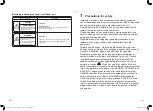
� 10 �
19-EN
20-EN
5
Refrigerant piping
Flaring
1. Cut the pipe with a pipe cutter.
Be sure to remove burrs that may cause a gas leak.
2. Insert the supplied flare nut into the pipe, and then
flare the pipe. The flare tools newly manufactured
for R410A are recommended.
However, the conventional tools
can be used by adjusting the
projection margin of the copper
pipe.
▼ Projection margin in flaring : B (Unit : in (mm))
Rigid (Clutch type)
Outer diameter of
copper pipe
R410A tool
used
Conventional
tool used
1/4” (6.4)
0 - 0.02” (0 - 0.5)
0.04” - 0.06”
(1.0 - 1.5)
1/2” (12.7)
▼ Flaring diameter size : A (Unit : in (mm))
Outer diameter of copper pipe
A
+0
-0.02”(–0.4)
1/4” (6.4)
0.39” (9.9)
1/2” (12.7)
0.65” (16.6)
* In case of flaring for R410A with the
conventional flare tool, pull the tool out
approx. 0.02” (0.5 mm) to adjust it to the
specified flare size.
The copper pipe gauge is useful for
adjusting the projection margin size.
CAUTION
TAKE NOTE OF THESE 4 IMPORTANT
POINTS BELOW FOR PIPING WORK
1. Keep dust and moisture away from inside the
connecting pipes.
2. Tightly connect the connection between pipes
and the unit.
3. Evacuate the air in the connecting pipes using
a VACUUM PUMP.
4. Check for gas leaks at connected points.
Tightening of flare connections
1. Align the centers of the flare connections and fully
tighten the flare nuts with your fingers.
Valve at liquid side
2. Use two wrenches to loosen or tighten the flare nut
on the gas service valve as shown in the figure.
Use only one wrench to loosen or tighten the flare
not on the liquid service valve.
The final tightening with a torque wrench should be
to the specifications shown in table below.
Unit : ft•Ibs (N•m)
Outer diameter of copper pipe
Tightening torque
1/4” (6.4 mm)
10 - 13 (14 - 18)
1/2” (12.7 mm)
37 - 46 (50 - 62)
Valve at gas side
• After the installation work, be sure to check for gas
leaks of the pipe connections with nitrogen.
NO GOOD
CAUTION
1. Do not put the crescent wrench on the charge
orifice or cover.
The valve may be broken.
2. If applying excessive torque, the nut may break
according to some installation conditions.
• Pressure of R410A is higher than that of R22
(Approx. 1.6 times).
Therefore, using a torque wrench, tighten the flare
pipe connecting sections that connect the indoor/
outdoor units at the specified tightening torque.
Incomplete connections may cause not only a gas
leak, but also trouble with the refrigeration cycle.
Do not apply refrigerant oil to the flared
surface.
EN
1131701101-00_S01_297x210_60p_S_p70_220426.indd 10
26/4/2565 11:41:09







































